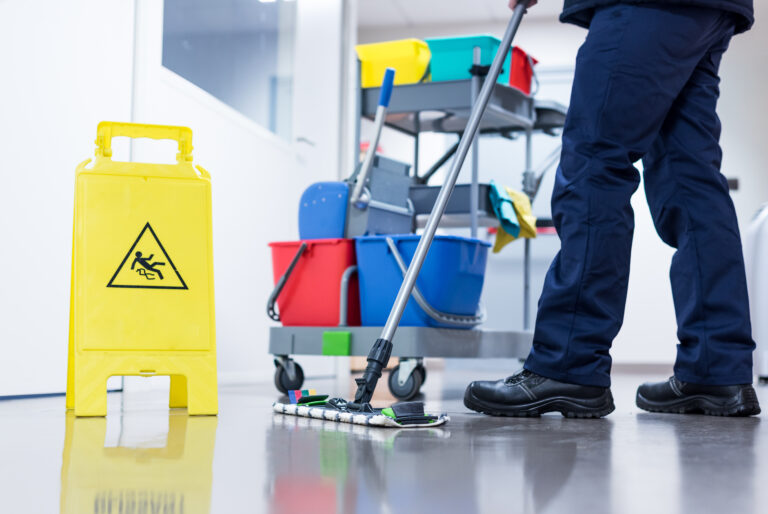Lately, cleaners have been fielding a lot of questions about our disinfecting products. It is always good news to have end users taking a close look at cleaning chemistry and asking for products that will make their infection prevention programs more robust. However, we don’t want to over-emphasize disinfection to the detriment of cleaning. Cleaning continues to be the cornerstone of any facility’s cleaning plan and should be the primary focus.
But don’t take my word for it! Industry best practices and health organizations like Health Canada and the U.S. Centers for Disease Control include cleaning as the important first step in the removal of soils including the coronavirus. Cleaning is the first step in removing soils and debris, allowing for a disinfectant to be effective when applied to the surface afterward.
Now is the time for cleaning companies and departments to focus on tweaking their regular cleaning processes and products, managing frequencies and efficiencies where possible. It is not necessarily the time to over-disinfect or invest in fancy new technology being marketed toward the recent pandemic – and it is never the time to stop regular cleaning with a solid, environmentally friendly general-purpose cleaner.
Cleaning vs. disinfecting
Let’s review the difference between cleaning and disinfecting:
Cleaning physically removes germs, dirt, and impurities from surfaces or objects by using a combination of soap (or detergent) and water. Disinfecting, on the other hand, works by using chemicals to kill germs on surfaces or objects.
The disinfection process should be considered to require two steps, starting with cleaning the surface or object. Next, that surface or object should be disinfected. In order for disinfecting to occur, a surface must be cleaned of all dirt and impurities so that the disinfectant can effectively kill those germs.
The dangers of too much disinfecting
When facilities start to use disinfectants only and skip the cleaning part of the equation, there can be real dangers to human health, effects on the environment, and a compromising of the building’s infection control measures.
Why is the two-step process necessary? First, disinfectants contain active ingredients that can be harsher than the ingredients in certain cleaners, so cannot be used in place of cleaners. These disinfectants should only be applied sparingly and when needed as part of your infection prevention plan on high-touch surfaces. The harsher active ingredients in these products can have adverse health effects on end users and building occupants when used too much or on their own. It is always recommended that disinfectants are sprayed in well-ventilated areas and that applicators wear the proper personal protective equipment (PPE) to keep cleaners safe.
Second, there is a financial element to the equation, the indiscriminate application of a disinfectant for cleaning purposes wastes money. Disinfectants are more concentrated and often more costly, so they are not a feasible financial replacement for cleaning products. Furthermore, soil, particles, and dust on a surface prevent the chemical reaction necessary to inactivate pathogens, including coronavirus. This becomes a waste of time and money, something no contractor or cleaning department can afford these days.
Follow the five steps to disinfecting protocol
Once you are ready to use a disinfectant on your high touch points, it is absolutely imperative to follow this five steps to disinfecting protocol.
- Use a registered product, and thoroughly read and understand the label and safety data sheets.
- Dilute it properly (regardless of your type of delivery method) and use a parts per million (PPM) litmus paper to test your dilution frequently to accommodate the type of facility and protocol.
- Always pre-clean the surface using a high-quality all-purpose cleaner.
- Respect and ensure that the dwell time is met.
- Include a potable water rinse according to each label, especially on food contact surfaces.
RELATED: Why reading chemical labels has never been more important
Be wary of false claims
It is no surprise that companies are creating and marketing all sorts of new formulas in the last few years as a defense against COVID-19. Claims from new antimicrobial surfaces to new types of virus-killing coatings that continue to work for seven days post-application. In times of heightened attention to public health, new companies have certainly made it into the market with spurious claims, trying to capitalize on the increased public demand for heightened hygiene.
In reality, if your facility had been paying attention to its infection prevention program before the pandemic, including regular and frequent cleaning, strong product choices, and following the five steps to disinfection protocol listed above, there should be no need to make any big changes when the risk of infection increases.
If you are over-disinfecting, or being lured by false marketing claims, you could get into dangerous territory for your company and your clients. Rely on the experts like your distributors, and local and federal health agencies to provide you with the resources, information, and tools to make healthy decisions for your commercial cleaning programs.
James Flieler is the VP of Sales North America for Charlotte Products Ltd. with over 40 years of expertise in all areas of sanitation. He is a renowned speaker and trainer for local businesses, key regional players, and national corporations across North America, and has conducted hundreds of hands-on presentations and training sessions.









